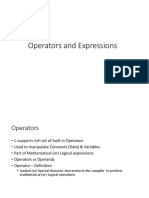Module2 - Part2
Uploaded by
Sonia DeviModule2 - Part2
Uploaded by
Sonia DeviPrinciples of Programming using C (BPOPS103/203) Module 2
SOME COMPUTATIONAL PROBLEMS
When expressions include real values, then it is important to take necessary precautions to guard
against certain computational errors due to approximations.
Another problem is division by zero. On most computers, any attempt to divide a number by zero
will result in abnormal termination of the program.
The third problem is to avoid overflow or underflow errors. It is our responsibility to guarantee that
the operands are of the correct type and range, and the result may not produce any overflow or
underflow.
TYPE CONVERSIONS IN EXPRESSIONS
Implicit Type Conversion
C permits mixing of constants and variables of different types in an expression. C automatically
converts any intermediate values to the proper type so that the expression can be evaluated without losing
any significance. This automatic conversion is known as implicit type conversion.
During evaluation it adheres to very strict rules of type conversion. If the operands are of different
types, the ‘lower’ type is automatically converted to the ‘higher’ type before the operation proceeds. The
result is of the higher type. A typical type conversion process is illustrated in the below Fig.
Given below is the sequence of promotion rules that are applied while evaluating expressions.
All short and char are automatically converted to int, then
1. If one of the operands is long double, the other will be converted to long double and the result will
be long double.
2. Else, if one of the operands is double, the other will be converted to double and the result will be
double.
3. Else, if one of the operands is float, the other will be converted to float and the result will be float.
CSE, CITECH 2022-23 Page 45
Principles of Programming using C (BPOPS103/203) Module 2
4. Else, if one of the operands is unsigned long int, the other will be converted to unsigned long int
and the result will be unsigned long int;
5. Else, if one of the operands is long int and the other is unsigned int, then
(a) If unsigned int can be converted to long int, the unsigned int operand will be converted
to long int.
(b) Else, both operands will be converted to unsigned long int and the result will be
unsigned long int.
6. Else, if one of the operands is long int, the other will be converted to long int and the result will be
long int.
7. Else, if one of the operands is unsigned int, the other will be converted to unsigned int and the
result will be unsigned int.
Conversion Hierarchy
Note that, C uses the rule that, in all expressions except assignments, any implicit type conversions
are made from a lower size type to a higher size type as shown below:
The final result of an expression is converted to the type of the variable on the left of the assignment sign
before assigning the value to it.
However, the following changes are introduced during the final assignment.
1. float, double to int causes truncation of the fractional part.
2. double to float causes rounding of digits.
3. long int to int causes dropping of the excess higher order bits.
int main()
{
int a=1;
CSE, CITECH 2022-23 Page 46
Principles of Programming using C (BPOPS103/203) Module 2
float b=4,c;
c=a/b;
output : 0.25
printf(“%f”,c);
return 0;
}
Explicit Conversion
There are instances when we want to force a type conversion in a way that is different from the automatic
conversion. Consider, for example, the calculation of ratio of females to males in a town.
ratio = female_number / male_number
Since female_number and male_number are declared as integers in the program, the decimal part
of the result of the division would be lost and ratio would represent a wrong figure. This problem can be
solved by converting locally one of the variables to the floating point as shown below:
ratio = (float) female_number / male_number
The operator (float) converts the female_number to floating point for the purpose of evaluation of
the expression. Then using the rule of automatic conversion, the division is performed in floating point
mode, thus retaining the fractional part of the result.
The process of such a local conversion is known as explicit conversion or casting a value. The
general form of a cast is:
(type-name) expression
Where type-name is one of the standard C data types. The expression may be a constant, variable or an
expression. Example
x= (int) 7.5 ; here 7.5 is converted to integer by truncation, (i.e) 7.
#include<stdio.h>
int main()
{
int a=1,b=4;
float c;
c=(float)a/b;
printf(“%f”,c);
return 0;
}
output : 0.25
#include<stdio.h> #include<stdio.h>
int main() int main()
CSE, CITECH 2022-23 Page 47
Principles of Programming using C (BPOPS103/203) Module 2
{ {
int a=1,b=4,c; int a=1;
c=a/b; float b=4,c;
printf(“%d”,c); c=a/b;
} printf(“%f”,c);
}
output: 0 output: 0.25
#include<stdio.h> #include<stdio.h>
int main() int main()
{ {
int a=1,c; float a=1,b=4,c;
float b=4; c=a/b;
c=a/b; printf(“%f”,c);
printf(“%d”,c); return 0;
return 0; }
} output: 0.25
output: 0
#include<stdio.h> #include<stdio.h>
int main() int main()
{ {
int a=1,b=4; int a=1,b=4;
float c; float c;
c=(float)a/b; c=a/(float)b;
printf(“%f”,c); printf(“%f”,c);
return 0; return 0;
} }
output: 0.25 output: 0.25
#include<stdio.h> #include<stdio.h>
int main() int main()
{ {
int a=1,b=4,c; float a=1,b=4;
c=(float)a/b; int c;
printf(“%d”,c); c=a/b;
return 0; printf(“%d”,c);
CSE, CITECH 2022-23 Page 48
Principles of Programming using C (BPOPS103/203) Module 2
} return 0;
}
output: 0 output: 0
EVALUATION OF EXPRESSIONS
Expressions are evaluated using an assignment statement of the form:
Variable = expression;
Examples of evaluation statements are:
x = a * b – c;
The numbers inside parenthesis refer to step numbers.
Consider the same expression with parenthesis as shown below:
9 – 12 / (3 + 3) * (2 – 1)
Whenever parentheses are used, the expressions within parentheses assume highest priority.
Step 1: 9 – 12 / 6 * (2 – 1)
Step 2: 9 – 12 / 6 * 1
Step 3: 9 – 2 * 1
Step 4: 9 – 2
Step 5: 7
While parentheses allow us to change the order of priority, we may also use them to improve the
understand-ability of the program.
First, parenthesized sub expressions from left to right are evaluated.
If parentheses are nested, the evaluation begins with the innermost sub-expression.
The precedence rule is applied in determining the order of application of operators in evaluating
sub-expressions.
The associativity rule is applied when two or more operators of the same precedence level appear in
a sub-expression.
Evaluate the following expressions:
(a) If a=3, d=7, e=2, c=5, b=4, x= --a*d/e-c++ * b, find a, b, c, d, e, x.
x= --a*d/e-c++ * b
x=--a*d/e-5*b (c++=5, c=c+1=5+1=6)
CSE, CITECH 2022-23 Page 49
Principles of Programming using C (BPOPS103/203) Module 2
x=2*d/e-5*b (--a=2,a=2)
x=2*7/2-5*4
x=14/2-5*4 (2*7=14)
x=7-5*4 (14/2=7)
x=7-20 (5*4=20)
x=-13 (7-20=-13)
a=2
b=4
c=6
d=7
e=2
x=-13
(b) If x=4, y=3, z=2, m=++x + --y + z++ + --z, find m, x, y, z.
m=++x + --y + z++ + --z
m=++x + --y + z++ + 1(--z=1, z=1)
m=++x + --y + 1 + 1 (z++=1, z=z+1=2)
m=++x + 2 + 1 + 1 (--y=2, y=2)
m=5 + 2 + 1 + 1 (++x=5, x=5)
m=7+1+1 (5+2=7)
m=8+1 (7+1=8)
m=9 (8+1=9)
x=5
y=2
z=2
(c) if x=20, y=5, find the value of the expression x= =10+15&&y<10
x= =10+15&&y<10
20==25&&5<10 (10+15=25)
20==25&&1 (5<10 is true, which is 1)
0&&1( 20==25 is false, which is 0)
0 (0&&1 is 0)
(d) if a=9,b=12,c=3, find the value of the expression a-b/3+c*2-1
a-b/3+c*2-1
9-12/3+3*2-1
9-4+3*2-1 (12/3=4)
9-4+6-1 (3*2=6)
5+6-1 (9-4=5)
11-1 (5+6=11)
CSE, CITECH 2022-23 Page 50
Principles of Programming using C (BPOPS103/203) Module 2
10 (11-1=10)
(e) if a=9,b=12,c=3, find the value of the expression a-b/(3+c)*(2-1)
a-b/(3+c)*(2-1)
9-12/(3+3)*(2-1)
9-12/6*(2-1) [3+3=6]
9-12/6*1 [2-1=1]
9-2*1 [12/6=2]
9-2 [2*1=2]
7 [9-2=7]
(f) if a=9,b=12,c=3, find the value of the expression a-(b/(3+c)*2)-1
a-(b/(3+c)*2)-1
9-(12/(3+3)*2)-1
9-(12/6*2)-1 [3+3=6]
9-(2*2)-1 [12/6=2]
9-4-1 [2*2=4]
5-1 [9-4=5]
4 [5-1=4]
(g) if a=9,b=12,c=3, find the value of the expression a-((b/3)+c*2)-1
a-((b/3)+c*2)-1
9-((12/3)+3*2)-1
9-(4+3*2)-1 [12/3=4]
9-(4+6)-1 [3*2=6]
9-10-1 [4+6=10]
-1-1 [9-10=-1]
-2 [-1-1=-2]
(h) 10!=10 || 5<4 && 8
10!=10 || 5<4 && 8
10!=10 || 0 && 8 (5<4 =0, false)
0||0 && 8 (10!=10 = 0, false)
0||0 (0 && 8 = 0, false)
0 (0 || 0 = 0, false)
CSE, CITECH 2022-23 Page 51
You might also like
- Data Types and Input or Output OperatorsNo ratings yetData Types and Input or Output Operators24 pages
- Notes On C Language: From: Prof Saroj Kaushik CSE Dept, IIT DelhiNo ratings yetNotes On C Language: From: Prof Saroj Kaushik CSE Dept, IIT Delhi55 pages
- C - Programming - Mariana Hack Tech 101No ratings yetC - Programming - Mariana Hack Tech 10120 pages
- 927623BME040 C Programming L Lab Record 2023 12 17No ratings yet927623BME040 C Programming L Lab Record 2023 12 1796 pages
- C Programming Laboratory (13MCA16) : 1 Prepared by Prof. Suma M.G., Asst. Professor - RNSIT, BangaloreNo ratings yetC Programming Laboratory (13MCA16) : 1 Prepared by Prof. Suma M.G., Asst. Professor - RNSIT, Bangalore34 pages
- Name:Jayash Singh Roll No:1311000924 course:MCA Subject Code and Nmae:1020 C Programming Semester:istNo ratings yetName:Jayash Singh Roll No:1311000924 course:MCA Subject Code and Nmae:1020 C Programming Semester:ist13 pages
- (C Programming) C Programming Extra Notes (Part 01) @BIJZLINo ratings yet(C Programming) C Programming Extra Notes (Part 01) @BIJZLI23 pages
- C-Programming and Data Structures Lab Manual100% (5)C-Programming and Data Structures Lab Manual251 pages
- Write A C Program To Calculate The Sum: Sum 1-x /2!+x /4!-x /6!+x /8!-x /10! Aim: To Calculate Sum 1-x AlgorithmNo ratings yetWrite A C Program To Calculate The Sum: Sum 1-x /2!+x /4!-x /6!+x /8!-x /10! Aim: To Calculate Sum 1-x Algorithm13 pages
- 01 - Introduction To Pervasive ComputingNo ratings yet01 - Introduction To Pervasive Computing82 pages
- Ser7 Ic: Serial To Seven Segment Controller Expandable To 32 DigitsNo ratings yetSer7 Ic: Serial To Seven Segment Controller Expandable To 32 Digits11 pages
- Sel-Table(Contactors for autotransformer starter)No ratings yetSel-Table(Contactors for autotransformer starter)1 page
- Zabbix 5 IT Infrastructure Monitoring Cookbook71-80No ratings yetZabbix 5 IT Infrastructure Monitoring Cookbook71-8010 pages
- Newmar Manual-APS-70 Automatic Power Selector 072514No ratings yetNewmar Manual-APS-70 Automatic Power Selector 0725142 pages
- Silo - Tips Simatic Simatic Modbus TCP Communication Via The Integrated PN Interface of The PLC ManualNo ratings yetSilo - Tips Simatic Simatic Modbus TCP Communication Via The Integrated PN Interface of The PLC Manual64 pages
- Presentation on vCloudPoint Solution by TechG InfotechNo ratings yetPresentation on vCloudPoint Solution by TechG Infotech31 pages
- UGRD-IT6311-Network-Infrastructure-and-Directory-Services-ALL LAB QuizessNo ratings yetUGRD-IT6311-Network-Infrastructure-and-Directory-Services-ALL LAB Quizess22 pages
- Definition of Computer Types of Personal Computer Common Parts of A Desktop ComputerNo ratings yetDefinition of Computer Types of Personal Computer Common Parts of A Desktop Computer49 pages
- Introduction Visual BASIC 6 0 1st Edition by Gary Haggard, Wade Hutchison, Christy Shibata ISBN 9788740303414 - Quickly download the ebook to never miss important content100% (6)Introduction Visual BASIC 6 0 1st Edition by Gary Haggard, Wade Hutchison, Christy Shibata ISBN 9788740303414 - Quickly download the ebook to never miss important content87 pages
- Module 5: Number Systems: Introduction To Networks v7.0 (ITN)No ratings yetModule 5: Number Systems: Introduction To Networks v7.0 (ITN)16 pages
- Part 1 - Introduction To The G1 Garbage Collector PDFNo ratings yetPart 1 - Introduction To The G1 Garbage Collector PDF16 pages
- Digital Dimming Thermostat Day & Night + Timer DTC-120: User ManualNo ratings yetDigital Dimming Thermostat Day & Night + Timer DTC-120: User Manual2 pages





































































































